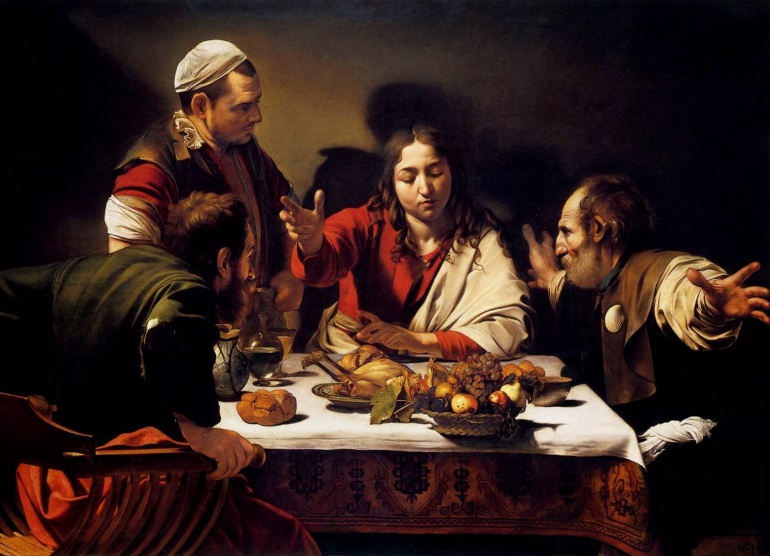
The most striking feature of the above painting “Supper at Emmaus”, is the beardless Christ. While it is true that early representations of Christ were beardless, based on the model of Apollo, the bearded Christ, based on the Mandylion, became convention around the 6th century. There must have been a very good reason for Caravaggio to have broken with convention. If we look to the Sistine Chapel again, specifically the Last Judgement, we see the same face and gesture used by Caravaggio on the figure of Christ painted by Michelangelo:

Caravaggio has echoed Michelangelo’s decision to use the youg beardless Christ (aka Apollo) This is our first clue as to the deeper meaning of the”Supper at Emmaus”.
Once again Caravaggio dresses his apostles and bystanders in contemporary dress. Compare the reaction of the apostles to the innkeeper, who is seemingly oblivious to the scene transpiring in front of him as the risen Christ reveals himself to apostles (from Luke 24:30 – 31). The innkeeper represents us, the everyman, who asks, “Would I have seen this miracle?”
A further clue to the meaning is the fruit basket, beautifully painted but leaning precariously on the ledge. This basket refers to the Last Judgement. From the Old Testament book of Amos 8:1-3: “This is what the Sovereign Lord showed me: a basket of ripe fruit. “What do you see, Amos?” he asked. A basket of ripe fruit,” I answered. Then the Lord said to me, ” The time is ripe for my people Israel; I will spare them no longer. “In that day”, declares the Sovereign Lord,” the songs in the Temple will turn to wailing. Many many bodies flung everywhere! Silence!
The painting is about salvation and judgement.
Many of the observations in these blog posts are sourced from the work of Italian art historian and painter Rodolfo Papa (http://www.rodolfopapa.it). I studied with Professor Papa in Rome. His studies and books on Caravaggio and sacred art are very interesting but unfortunately (for now) they are only in Italian.
I also highly recommend Dr. John Spike’s book on Caravaggio which is also another source for these posts.
The best book for high quality reproductions is by Sebastion Schutze. It is 12 x 16 inches and is full of hi-res close ups. One can see paint quality in the images. Highly recommended for the Caravaggio enthusiast.

Leonardo da Vinci’s Last Supper also has a beardless Christ. Perhaps this painting was an important example for Caravaggio.
LikeLike